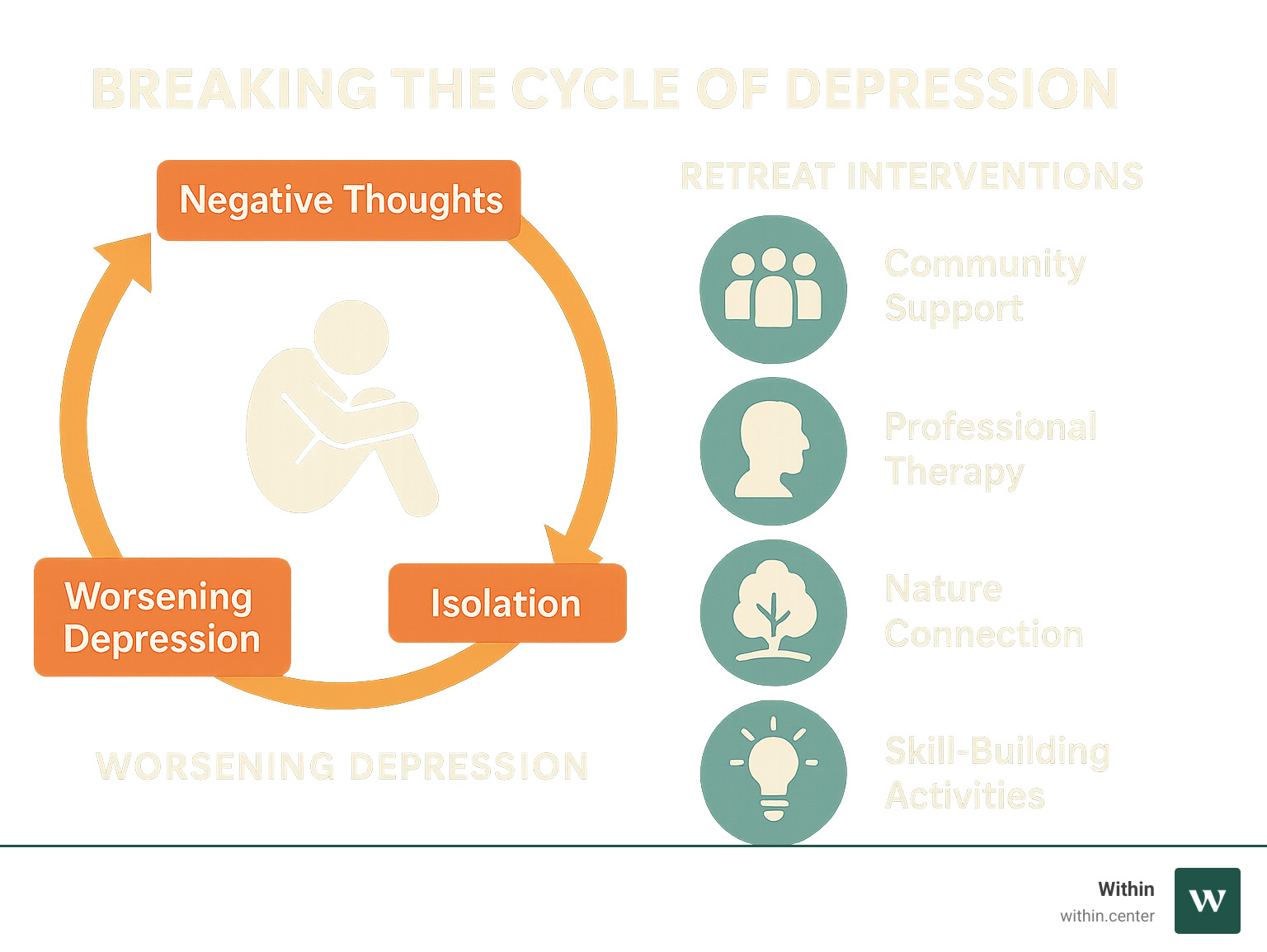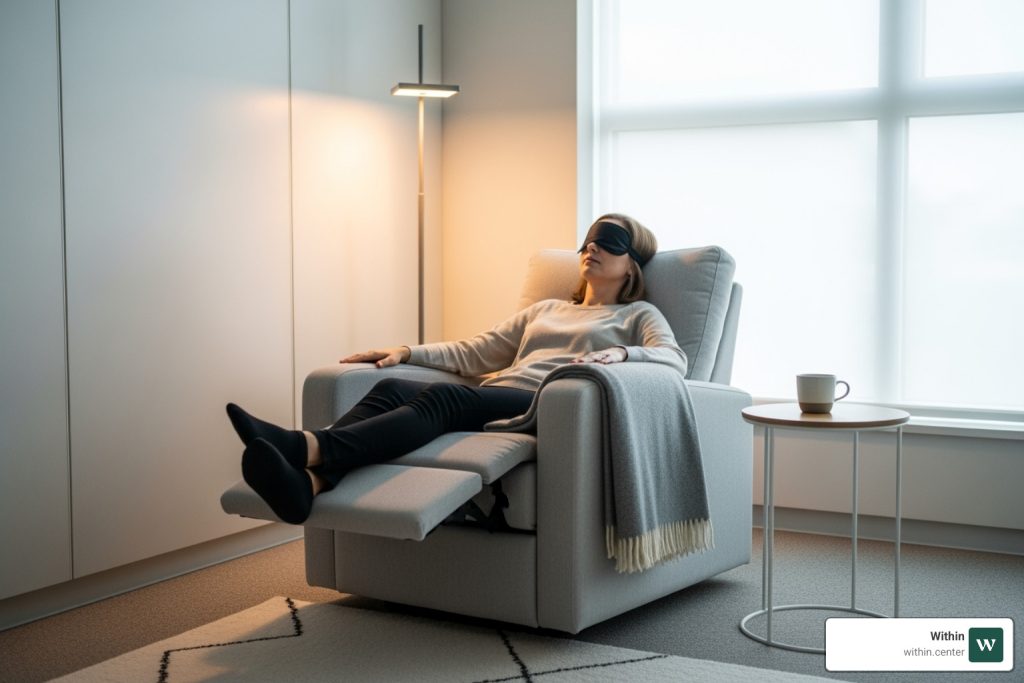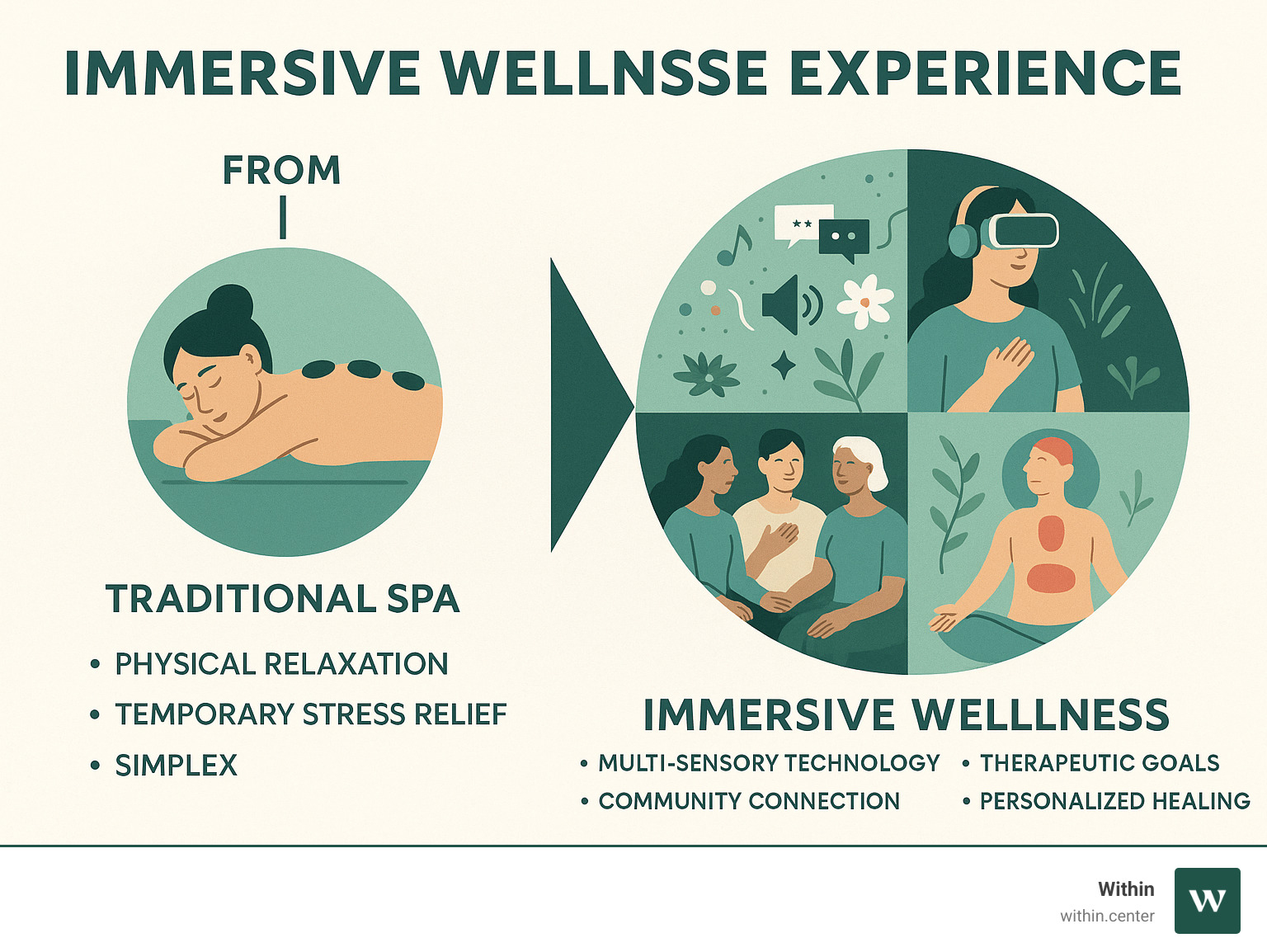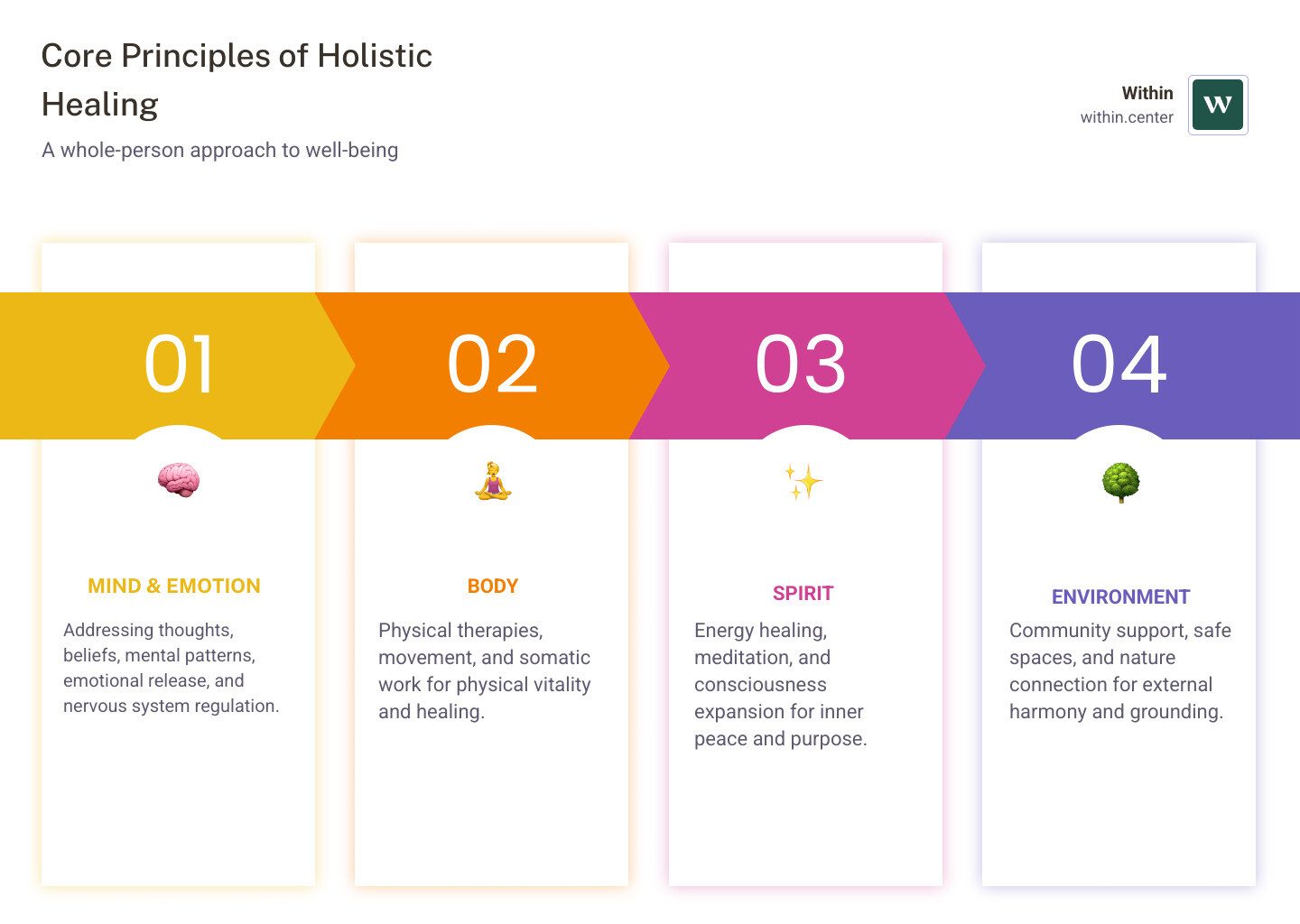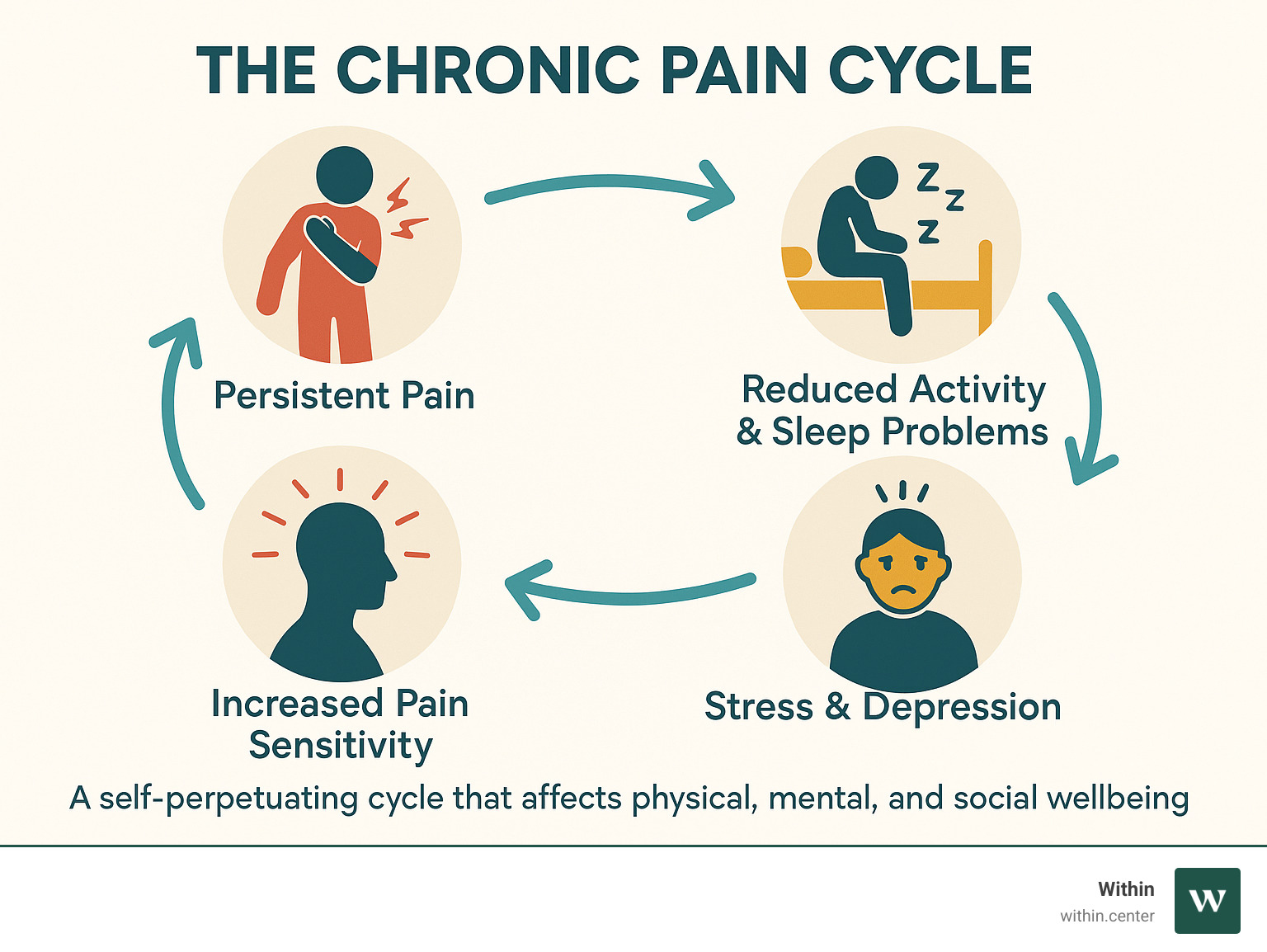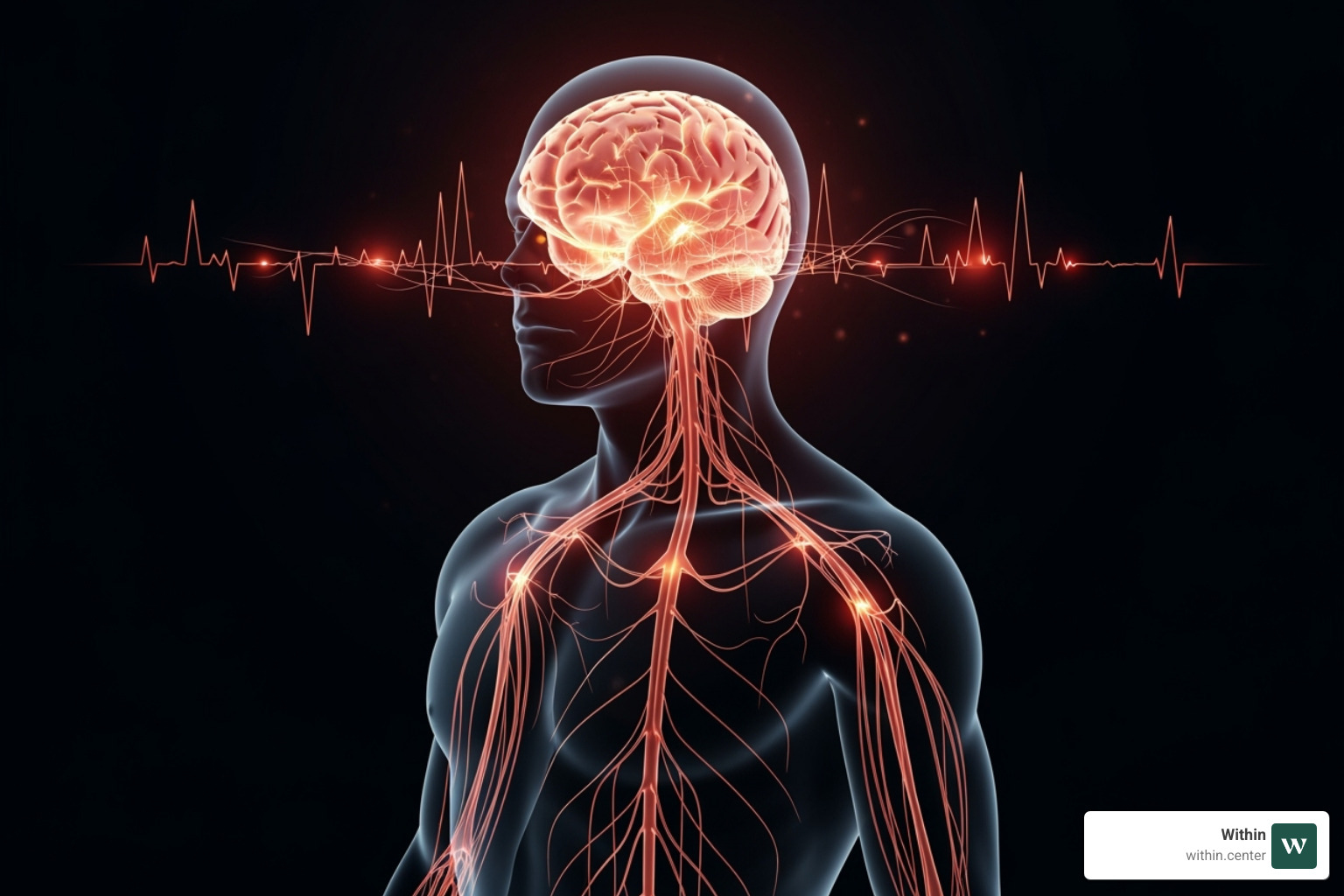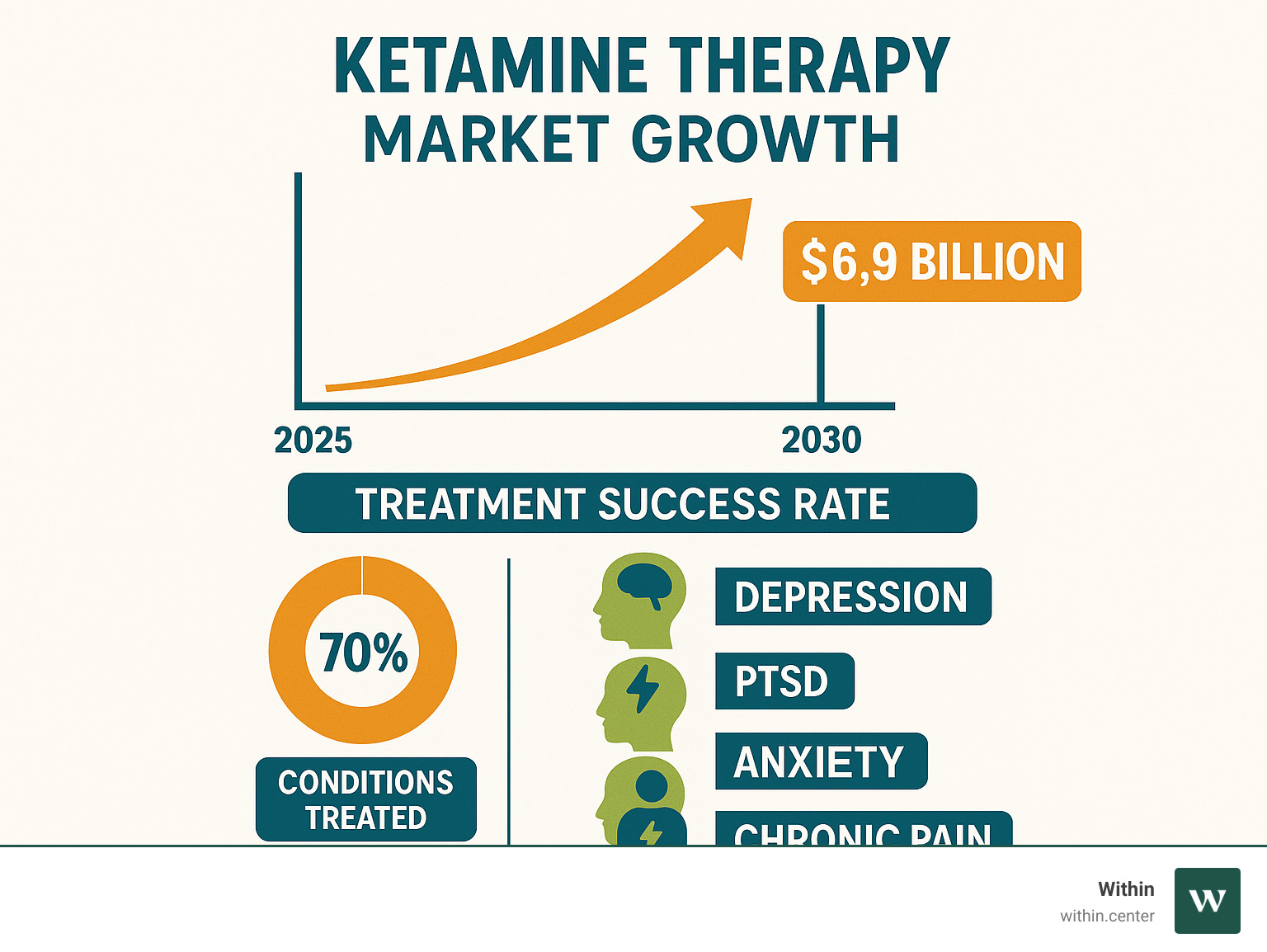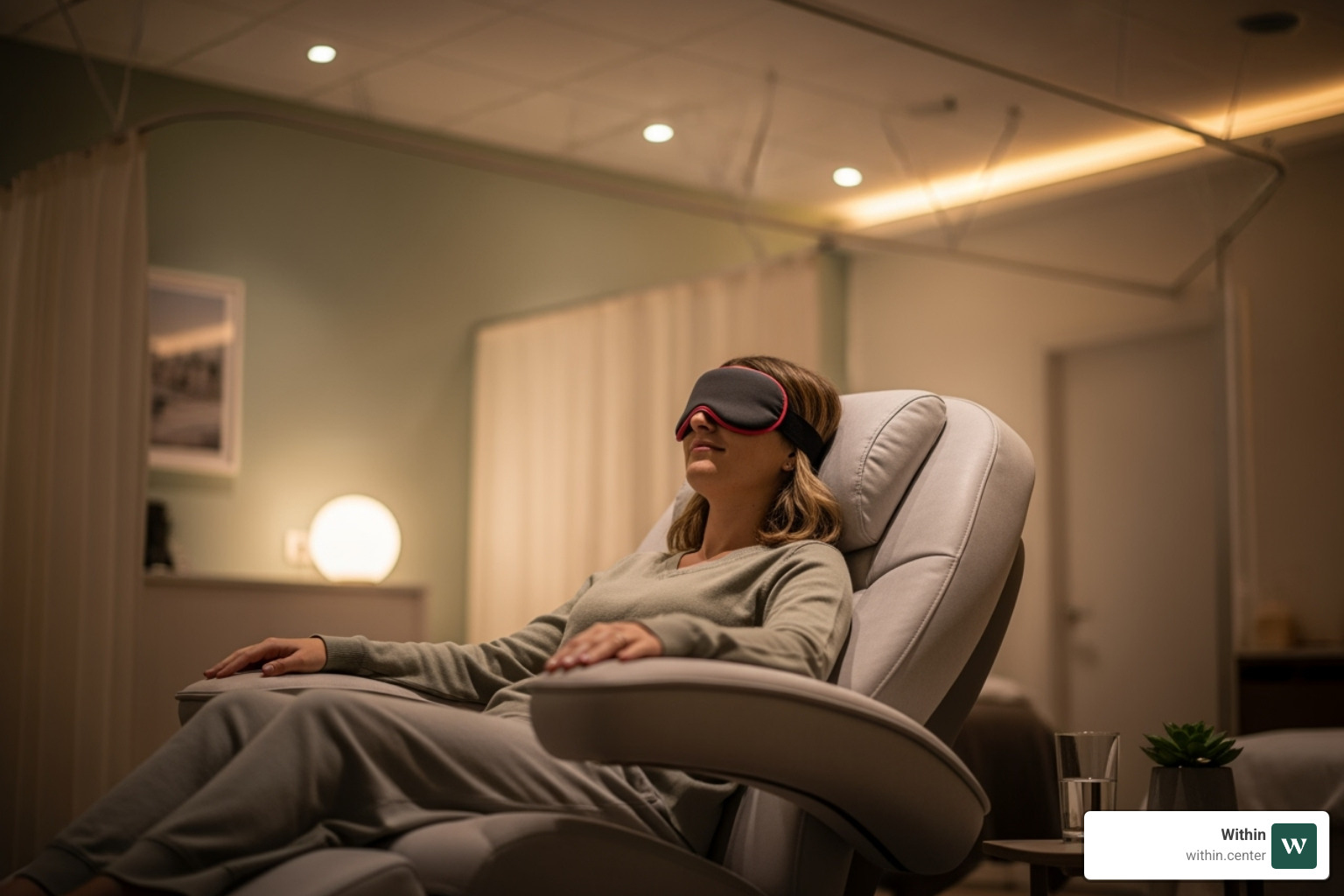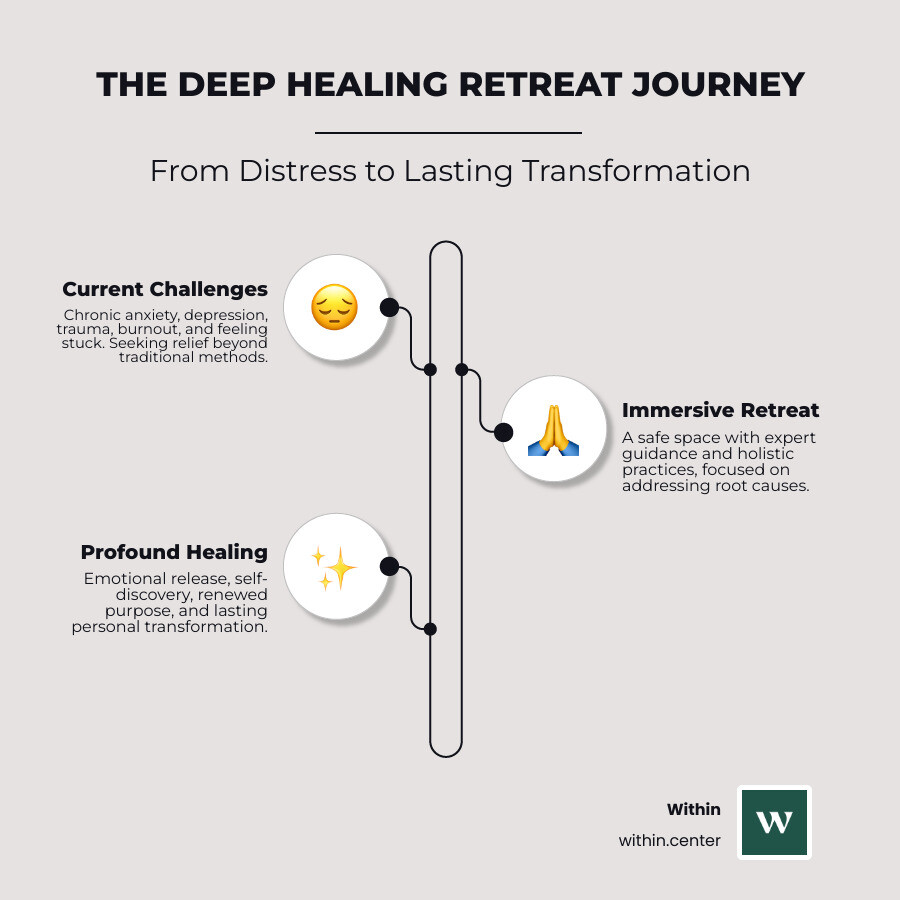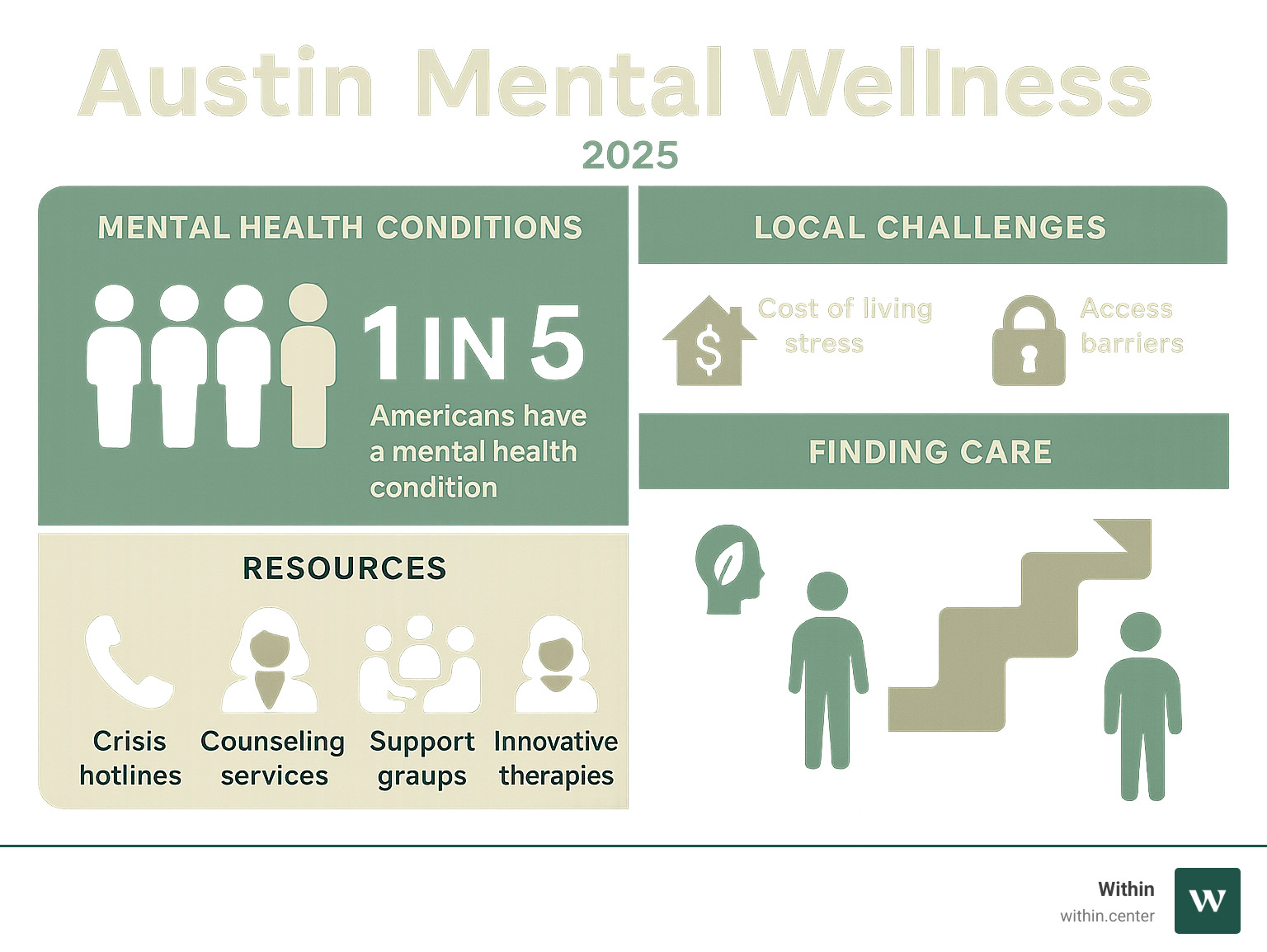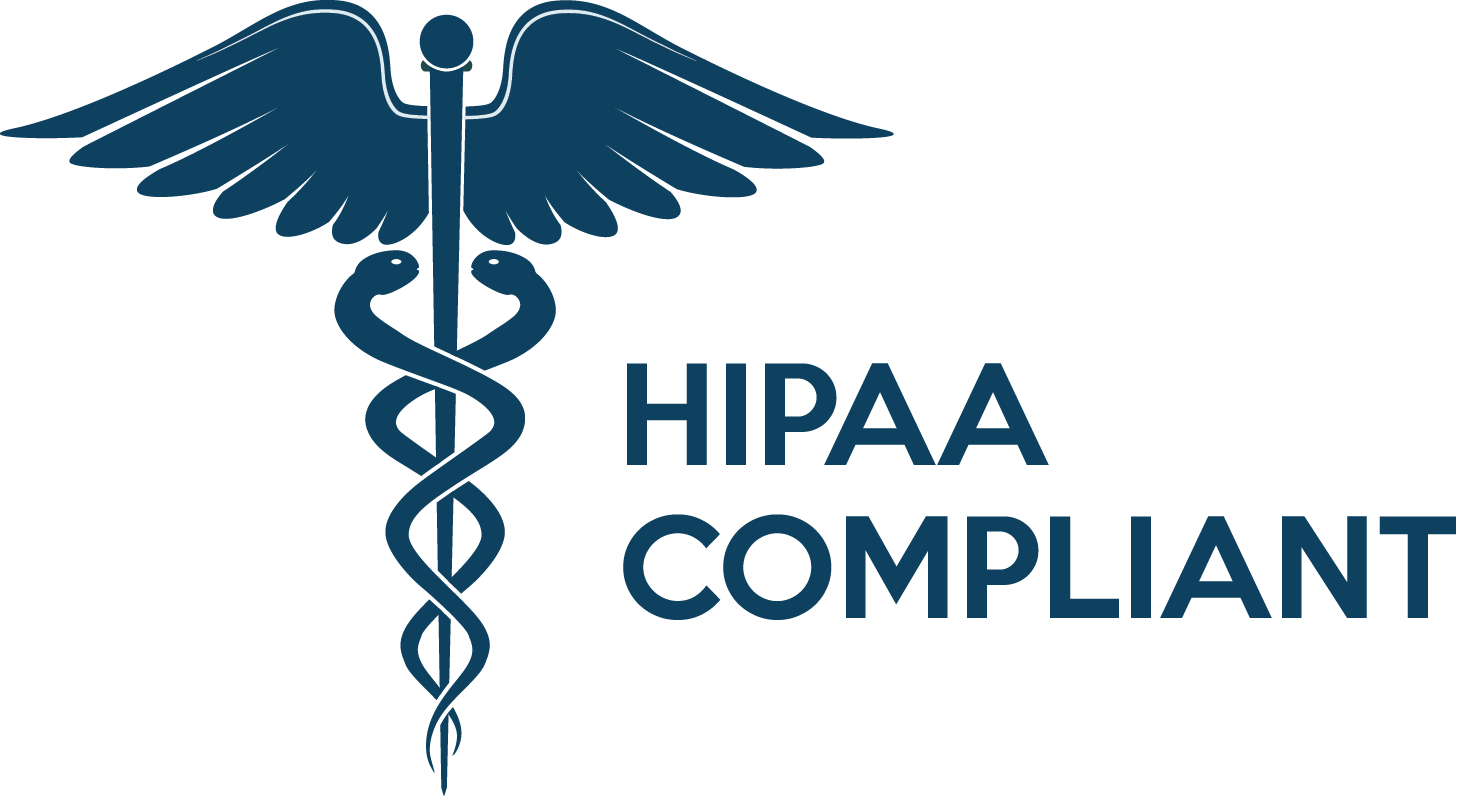
A mental health wellness retreat offers an immersive, intensive healing experience that combines evidence-based therapy with holistic practices in supportive, natural environments. Unlike traditional outpatient therapy, these retreats provide 24/7 structured support, personalized treatment plans, and a complete break from daily stressors to accelerate mental health recovery.
Quick Guide to Mental Health Wellness Retreats:
- Duration: 3 days to 8+ weeks depending on program intensity
- Cost Range: $600 – $4,000+ for shorter programs
- Common Treatments: CBT, DBT, EMDR, mindfulness, yoga, nature therapy
- Best For: Treatment-resistant depression, anxiety, PTSD, burnout, life transitions
- Key Benefit: Intensive, focused healing away from daily triggers
The numbers tell a stark story about our mental health crisis. Depression affects over 17 million Americans, making it the second most common mental health disorder. Anxiety disorders impact more than 40 million Americans annually, yet many find traditional weekly therapy sessions insufficient for breakthrough healing.
As one retreat guest shared: “They do an incredible job–from the moment we land–of this liftd hospitality. So there is always an element of feeling that I am supported, that I am held. That there are people wanting to take care of me.”
When daily life becomes overwhelming and traditional therapy feels stuck, a mental health wellness retreat offers something different. It’s an investment in profound healing that goes beyond managing symptoms to address root causes and create lasting change.
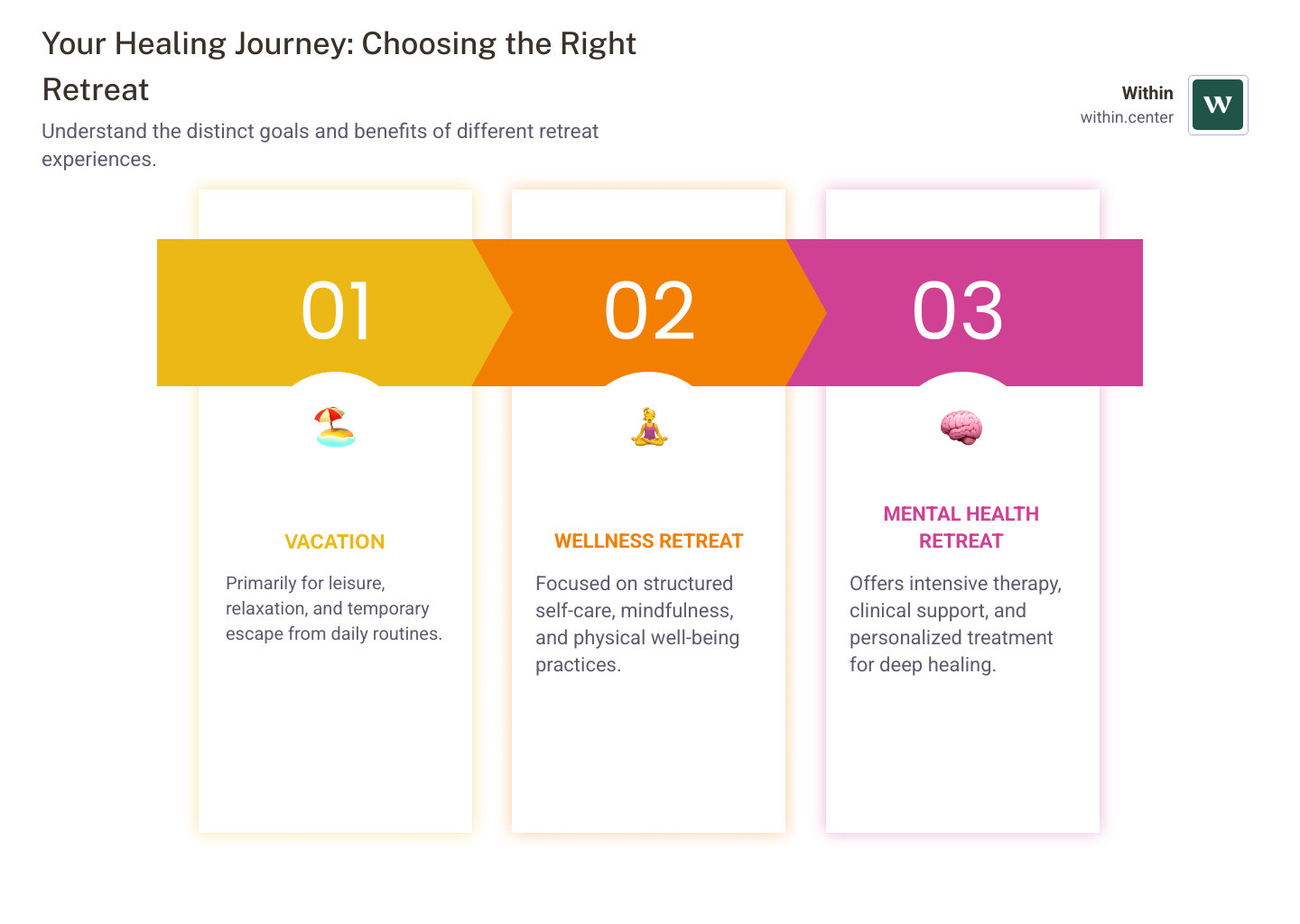
Why Choose a Mental Health Wellness Retreat Over Traditional Therapy?
Trying to heal while immersed in the daily chaos that fuels your struggles can feel counterproductive. That’s where a mental health wellness retreat offers a different path. Instead of squeezing healing into hour-long sessions, it creates a protective bubble for your recovery.
By stepping away from your usual environment—free from work emails, household chores, and familiar triggers—you enter an immersive environment designed for breakthrough healing. This isn’t about escaping problems, but creating the ideal conditions to solve them.
Free from daily fire-fighting, you can focus on deeper work. Breaking daily routines that keep you stuck becomes easier when you’re removed from them. This allows for focused healing, where you dive straight into meaningful work instead of recapping the week’s events. This fosters a deeper connection with yourself and the therapeutic process.
What truly sets retreats apart is the community support from others on similar journeys and the 24/7 support structure. Help is always available, whether you’re processing trauma late at night or have a breakthrough during meditation. This continuous support catches crucial moments that weekly check-ins can miss.
| Factor | Mental Health Retreat | Traditional Outpatient Therapy |
| Intensity | High; immersive, multi-day, structured program | Moderate; typically 1-2 sessions per week |
| Environment | Dedicated, supportive, often natural/serene setting | Familiar home/office environment, daily stressors remain |
| Time Commitment | Full-time; days to weeks, living on-site | Part-time; hours per week, fitting into daily schedule |
| Support Structure | 24/7 access to staff and peer community, structured activities | Weekly scheduled sessions, self-management between sessions |
Signs You Might Benefit from a Retreat
Sometimes the signs are whispers. Other times they’re screaming sirens. Here’s what we often hear from people who find their way to retreats:
Feeling stuck: You’ve been in therapy for a while, but it feels like you’re spinning your wheels, facing the same issues without making progress.
Persistent burnout: You’re experiencing a bone-deep exhaustion that rest can’t fix, making even small tasks feel overwhelming.
Overwhelmed by stress: Your stress levels are chronically high, affecting your health, sleep, and relationships, and your usual coping strategies aren’t working.
Life transitions: You’re navigating a major life change—like a divorce, job loss, or grief—and need more support than weekly therapy can offer.
Traditional therapy plateau: You feel you’ve stopped making progress in your current therapy and may need a different approach to break through.
Needing new coping skills: Your old strategies are no longer effective, or you need to learn healthy ways to cope for the first time.
If any of this resonates, you might benefit from the deeper, more intensive approach that a retreat offers. For those curious about innovative healing approaches, you can learn more about healing through awe and connection.
The Core Benefits of a Dedicated Healing Space

There’s something almost magical about stepping into a space designed entirely for healing. It’s like the difference between trying to meditate in your cluttered bedroom versus a peaceful temple.
Mental clarity: By removing daily distractions and decision fatigue, your mind can quiet down, allowing you to hear your own thoughts.
Emotional regulation: A safe, non-triggering environment makes it easier to learn and practice new emotional skills before returning to daily life.
Building resilience: Dedicated time allows you to integrate new tools until they become second nature, making them more effective than skills learned in a single hour-long session.
Acquiring new tools: Learning is immersive, not theoretical. You’ll practice new skills like yoga, breathwork, and mindfulness throughout the day.
Lasting change: Immersing yourself in new, healthy habits for an extended period makes them more likely to stick than practicing them for just an hour a week.
Holistic well-being: Retreats treat the whole person, understanding that mental health is connected to physical and spiritual wellness.
Disconnecting to reconnect: Stepping away from external roles and expectations gives you the space to find yourself again.
What to Expect: A Look Inside Retreat Programs and Therapies
When you arrive at a mental health wellness retreat, you enter a space designed for your healing. A quality retreat creates personalized treatment plans based on a thorough assessment, crafting a program for your unique needs. It’s about finding your own path.
Retreats are powerful because they honor the mind-body-spirit connection, recognizing that emotional distress manifests physically and spiritually. They weave together evidence-based therapies with holistic practices to nourish every part of you.
A typical day might blend individual therapy, yoga, and group discussions, with each activity building on the others. Common retreat activities include therapy, mindfulness, yoga, nature walks, nourishing meals, and creative workshops. These elements work together to build a healing momentum that’s difficult to achieve in weekly therapy.
Evidence-Based and Clinical Therapies
The clinical foundation of any solid mental health wellness retreat rests on therapies that science has proven effective. These aren’t experimental approaches—they’re time-tested methods that have helped millions of people reclaim their lives.
Cognitive Behavioral Therapy (CBT) helps you identify, question, and replace negative thought patterns with more realistic, compassionate perspectives.
Dialectical Behavior Therapy (DBT) teaches practical skills to manage intense emotions, improve relationships, and stay grounded when life feels chaotic.
For trauma, EMDR (Eye Movement Desensitization and Reprocessing) helps the brain process difficult memories so they lose their emotional sting. One guest shared it resolved their underlying trauma, improving sleep and calming their nervous system.
Somatic experiencing addresses trauma stored in the body. Through gentle awareness practices, you learn to release tension and complete stuck fight-or-flight responses.
Group therapy fosters healing through shared understanding, while individual counseling provides a safe, private space to explore your deepest concerns.
For those seeking innovative approaches, some retreats incorporate advanced treatments. At Within, we offer psychedelic therapy administered by trained professionals in a supportive setting. These cutting-edge modalities can create profound shifts in perspective, especially for treatment-resistant conditions.
Holistic and Experiential Approaches
Beyond traditional therapy, mental health wellness retreats accept practices that heal the whole person. These approaches, blending ancient wisdom with modern science, often create the “aha moments” that change everything.

Mindfulness and meditation teach you to observe your thoughts calmly, while yoga uses movement and breath to reconnect you with your body.
Breathwork uses conscious breathing techniques to calm the nervous system and release stored emotions, with surprisingly powerful results.
Nature therapy, or “forest bathing,” uses the healing power of nature to reduce stress. Hiking or simply being in nature can lower stress hormones and put things in perspective.
Art therapy allows you to express what words can’t capture through painting, sculpting, or writing, encouraging authentic expression.
Sound healing uses vibrations from instruments to induce deep relaxation. Some retreats also offer sensory deprivation float tanks for a complete nervous system reset.
These practices aren’t just feel-good additions—they’re essential parts of healing that help bridge the gap between mind, body, and spirit. At Within, we’ve seen how combining innovative treatments like ketamine therapy with these holistic approaches creates lasting change that goes far beyond symptom relief.
How to Choose the Right Mental Health Retreat for Your Needs
Finding the right mental health wellness retreat is a deeply personal journey. What works for one person might not for another, so start with an honest self-assessment. Reflect on your current challenges: Are you feeling stuck, dealing with trauma, or simply exhausted?
Get clear on your goals, whether it’s learning new coping skills, processing a difficult experience, or refinding yourself.
Once you know what you need, start researching specialties. Look for retreats that have experience with your specific challenges. Reading testimonials from people with similar struggles can provide insight, but also try to understand the philosophy of each retreat. Does their clinical, holistic, or blended approach resonate with you?
One crucial element to look for is comprehensive integration support. The real test of a retreat’s value comes when you return to daily life. Ongoing guidance is what transforms a powerful experience into lasting change. For deeper insight into why this matters so much, explore the importance of integration support.
Finding a Mental Health Wellness Retreat for Specific Conditions
Many people come to a mental health wellness retreat because they’re struggling with something specific, and they need more intensive support than weekly therapy can provide.
When addressing anxiety, look for programs combining CBT and EMDR with calming practices like breathwork and meditation. The best retreats integrate mind-body approaches to teach practical tools and calm the nervous system.
For healing from trauma, a safe, trauma-informed environment is essential. Seek programs with specialized therapies like EMDR and somatic experiencing, delivered by qualified therapists. Some offer support for specific groups like first responders.
To manage clinical depression, an intensive retreat can be a catalyst for breakthroughs. Look for programs combining evidence-based therapies like CBT and DBT with supportive activities, nutrition, and community, like those for clinical depression.
For coping with grief, find a retreat offering compassionate counseling and group support. They should provide a safe space to process emotions without rushing the healing process.
To overcome burnout, seek programs that address its root causes, teach sustainable stress management, and help you reconnect with your values to prevent future burnout.
The Role of Personalized Care and Natural Environments
A truly transformative mental health wellness retreat combines individualized plans with a healing environment. The best programs create a custom experience based on a thorough assessment, tailoring therapies and practices to your unique goals.

The restorative power of nature is also key. Serene settings like forests or mountains are proven to reduce stress and calm the nervous system.
Outdoor activities like meditation or therapy are active parts of healing. Nature grounds you and provides the peace needed for improved self-growth and reflection.
Finding Your Ideal Mental Health Wellness Retreat Focus
To narrow your options, consider the retreat’s focus. Is it clinical (intensive therapy for diagnosed conditions) or holistic (mind-body-spirit practices)? Many excellent programs, like Within, combine both.
Decide between a spiritual focus (meditation, energy work) or a secular one focused on psychology and wellness.
Do you prefer an individual focus or a group-centric environment? Most retreats offer a mix, but the emphasis varies.
Finally, consider the duration. Short-term stays (3-4 days) offer a reset, while long-term programs (a week or more) allow for deeper work. Your choice depends on your goals and practical needs.
The Practicalities: Costs, Logistics, and Preparation
Let’s talk about the practical side of planning your mental health wellness retreat – because while the healing journey is deeply personal, the logistics need to be crystal clear.
Understanding costs can feel overwhelming at first, but most retreats are quite transparent about their pricing. You’ll typically find that shorter programs range from $600 to $4,000, while longer or more intensive experiences can cost significantly more. The investment varies based on duration, location, level of accommodation, and the specific therapies included in your program.
Most quality retreats offer all-inclusive packages, which we highly recommend exploring. These packages typically bundle your accommodation, all meals, therapeutic sessions, and activities into one transparent price. This approach eliminates surprise costs and lets you focus entirely on your healing without worrying about additional expenses.
Insurance coverage questions come up frequently, and the answer isn’t always straightforward. While many retreats are considered elective wellness experiences, some programs with strong clinical components may qualify for partial insurance reimbursement. We always suggest calling your insurance provider directly to understand your benefits. Some retreats also offer payment options like financing plans to make the investment more manageable.
What’s included should be clearly outlined before you commit. This typically covers everything from airport transfers to specific therapeutic sessions, meals, accommodation, and planned activities. Understanding these details helps you prepare properly and sets realistic expectations for your experience.
Packing for a retreat doesn’t have to be stressful. While each program has unique requirements, essentials usually include comfortable clothing for various activities, personal hygiene items, and any specific gear for outdoor activities like hiking or yoga. For comprehensive packing guidance, check out this helpful resource on what to pack for a wellness retreat.
Perhaps most importantly, we encourage you to spend time setting intentions before you arrive. What do you hope to gain from this experience? What patterns are you ready to release? What new skills do you want to develop? Having clear intentions helps you maximize your retreat experience and directs your energy toward meaningful healing.
Think of this preparation time as the beginning of your healing journey. The more thoughtfully you approach the practical aspects, the more fully you can surrender to the transformative process once you arrive.
Frequently Asked Questions about Mental Health Retreats
When people first learn about mental health wellness retreats, they often have questions about how they work and what makes them different from other healing approaches. Let’s explore the most common questions we hear.
What is the main difference between a wellness retreat and a vacation?
The main difference is intention and structure. A vacation is for leisure and temporary relaxation. A mental health wellness retreat is an active, intentional journey toward healing, with a structured schedule of therapeutic sessions, workshops, and guided practices.
While a vacation offers a temporary refresh, a retreat aims for lasting change, equipping you with new tools and insights for your daily life.
How long are most mental health retreats?
The duration of a mental health wellness retreat varies to meet different needs. Short intensive weekends (3-4 days) are effective for a powerful reset. Week-long programs are a popular choice, allowing enough time to disconnect, dive deep into therapy, and build new habits.
For more complex conditions, longer-term residential programs of 30 days or more offer the most intensive support for deep healing and integration. Our immersive retreats at Within are designed to provide ample time for both healing and integration, ensuring you leave with sustainable tools.
Is a retreat a substitute for long-term therapy?
A mental health wellness retreat is not a substitute for long-term therapy, but a powerful complement to it. The intensive, immersive environment can accelerate healing and provide breakthroughs that might take months to achieve in weekly sessions.
Think of a retreat as a catalyst that jumpstarts or deepens your healing journey. However, ongoing therapy helps maintain that progress. The most effective retreats emphasize this by providing comprehensive integration support and aftercare plans to help you apply what you’ve learned back in your daily life.
A retreat is best viewed as an intensive boost within a broader mental wellness strategy, ideal for breaking through a plateau, addressing a crisis, or deepening your ongoing therapeutic work.
Conclusion: Your Journey to Healing Begins Here
Taking the first step toward a mental health wellness retreat requires courage, but it’s one of the most meaningful investments you can make in your well-being. When daily life feels overwhelming and traditional approaches aren’t providing the breakthrough you need, a dedicated healing space offers something transformative.
The power of stepping away from your familiar environment cannot be overstated. In a retreat setting, you’re not just getting therapy—you’re immersing yourself completely in the healing process. Without the constant pull of work emails, household responsibilities, or social obligations, you can finally give your mental health the focused attention it deserves.
What makes this approach so effective is how it allows you to disconnect in order to reconnect. Away from the noise and stress of everyday life, you refind parts of yourself that may have been buried under layers of anxiety, depression, or burnout. You find hope again. You learn new strategies for managing life’s challenges. Most importantly, you remember your own strength and resilience.
For those seeking an immersive experience that combines clinical innovation with holistic care, Within offers a unique path forward. Our approach at AWKN Ranch near Austin, Texas creates a live-in retreat experience where ketamine-assisted therapy meets comprehensive integration support. It’s not just about the treatment itself—it’s about building a community focused on lasting change and holistic well-being.
Your journey toward a stronger, more peaceful version of yourself begins with acknowledging that you deserve this level of care and attention. If you’re ready to explore how an intensive, supportive environment can open up your potential for healing, we’re here to guide you.
Explore a Psychedelic Therapy Retreat and find how our personalized programs can help you create the lasting change you’ve been seeking. Your future self is waiting.

